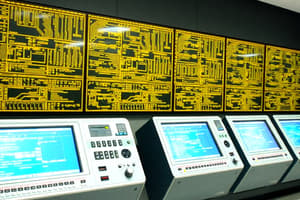Podcast
Questions and Answers
What is the primary role of an operating system in a computer system?
What is the primary role of an operating system in a computer system?
- Directly executes user programs without any intermediaries.
- Acts as a barrier between hardware and software.
- Serves as an intermediary between a user and hardware. (correct)
- Focuses solely on memory management.
Which of the following is NOT an objective of an operating system?
Which of the following is NOT an objective of an operating system?
- Executing user programs.
- Providing a user-friendly interface.
- Managing user passwords and security settings. (correct)
- Efficient utilization of hardware resources.
Which type of system is characterized by multiple processors working on separate tasks for faster processing?
Which type of system is characterized by multiple processors working on separate tasks for faster processing?
- Real-Time Systems
- Mainframe Systems
- Multiprocessor Systems (correct)
- Distributed Systems
What is the function of virtual memory in an operating system?
What is the function of virtual memory in an operating system?
Which type of computing environment is designed for tasks that must meet strict timing constraints?
Which type of computing environment is designed for tasks that must meet strict timing constraints?
What does the term 'deadlock' refer to in process management?
What does the term 'deadlock' refer to in process management?
Which method is NOT typically associated with file allocation strategies in operating systems?
Which method is NOT typically associated with file allocation strategies in operating systems?
What is meant by the term 'CPU scheduling' in the context of process management?
What is meant by the term 'CPU scheduling' in the context of process management?
What primary function does an operating system serve?
What primary function does an operating system serve?
What is the purpose of a kernel in an operating system?
What is the purpose of a kernel in an operating system?
Which of the following describes mainframe systems?
Which of the following describes mainframe systems?
What distinguishes time-sharing systems from other computing systems?
What distinguishes time-sharing systems from other computing systems?
How do desktop systems primarily differ from mainframe systems?
How do desktop systems primarily differ from mainframe systems?
What is a characteristic of multiprocessor systems?
What is a characteristic of multiprocessor systems?
What key advantage do distributed systems offer?
What key advantage do distributed systems offer?
What is asymmetric clustering?
What is asymmetric clustering?
Which statement is true regarding real-time systems?
Which statement is true regarding real-time systems?
What is a common drawback of handheld systems?
What is a common drawback of handheld systems?
Which computing environment allows for convenient remote access?
Which computing environment allows for convenient remote access?
What is a defining feature of soft real-time systems?
What is a defining feature of soft real-time systems?
What is the benefit of having a loosely coupled system in distributed computing?
What is the benefit of having a loosely coupled system in distributed computing?
Flashcards are hidden until you start studying
Study Notes
Operating Systems
- An operating system acts as an intermediary between a user and their hardware.
- An operating system aims to:
- Execute user programs.
- Solve problems for the user.
- Utilize hardware efficiently.
- Make the user's experience easier.
- The core of an operating system is called the "kernel". It runs constantly.
Computer System Components
- A computer system comprises four elements:
- Hardware.
- Operating System.
- Application Programs.
- Users.
Mainframe Systems
- Mainframe systems were developed to reduce setup time by grouping similar jobs together.
- They were designed for automatic job sequencing, transferring control from one job to another.
- Multi-programmed batch Systems are systems with several jobs running concurrently, and the CPU shares time among them.
- Time-Sharing Systems enable interactive computing by multiplexing the CPU among jobs in memory and on disk.
Desktop Systems
- Desktop systems cater to a single user.
- They are characterized by their user-friendliness and responsiveness.
- They rely on technology developed for larger operating systems, offering user convenience.
- They can run various operating systems like Windows, MacOS, Unix, and Linux.
Multiprocessor Systems
- Multiprocessor systems consist of multiple CPUs that communicate with each other.
- They allow for increased throughput, efficiency, and reliability.
- They are used for parallel processing, resulting in faster computation.
Distributed Systems
- Distributed systems distribute computation across multiple physical processors with independent memory.
- They involve loosely coupled systems communicating through communication lines.
- They offer benefits like resource sharing, increased computation speed, and enhanced reliability.
Clustered Systems
- Clustered systems allow multiple systems to share storage for increased reliability.
- There are two types of clustering:
- Asymmetric clustering: One server runs applications, while others are on standby.
- Symmetric clustering: All servers run applications.
Real-Time Systems
- Real-time systems are used in dedicated applications with precise timing requirements, such as scientific experiments or industrial control systems.
- They can be hard or soft.
- Hard real-time systems are limited or lack secondary storage and rely on memory or ROM.
- Soft real-time systems integrate with time-sharing systems but have limited capabilities for industrial control.
Handheld Systems
- Handheld systems like PDAs, cellular phones, and smartphones, are characterized by limited memory, slow processors, and small displays.
Computing Environments
- There are three primary computing environments:
- Traditional computing: PCs, servers, limited remote access.
- Web-based computing: Client-server, web services, convenient and location-less servers.
- Embedded computing: Limited operating system features, minimal or no user interface, remote access.
Studying That Suits You
Use AI to generate personalized quizzes and flashcards to suit your learning preferences.




